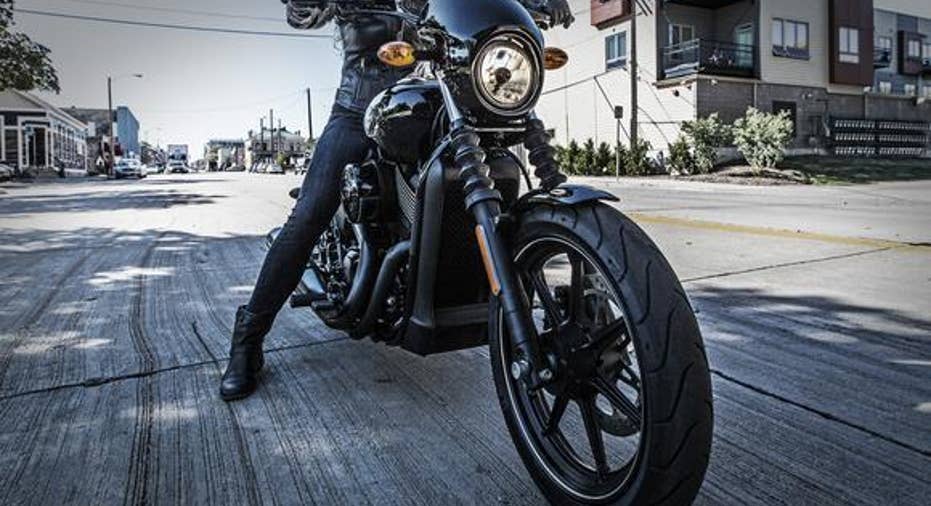Can Harley-Davidson Inc. Stop Sliding Sales With This Strategy?

Harley-Davidson hasn't been smoking the competition lately, but putting new riders on its newest bike just might help it grow sales again. Photo: Harley-Davidson.
Sounding like a 1970s Edgar Winter hit tune, Harley-Davidson is hoping that free rides are the ticket to higher revenues.
The motorcycle maker is in the midst of a protracted sales slump, with third quarter sales down 1.4% worldwide and 2.5% in the U.S. That led it to reduce dealer shipment guidance 4% to a range of 265,000 to 270,000 motorcycles.
Harley admits one of the issues may be its insistence on holding the line on pricing. The company has preferred to protect its margins, though much of the rest of the industry has resorted to discounting. While Indian Motorcycle maker Polaris Industries notched a 154% gain in motorcycle sales, it came at a cost, as gross margin percentage tumbled 126 basis points company-wide. In contrast, Harley's margins remained largely unchanged.
Of course, there are reasons for the disparity besides promotional pricing. Motorcycles make up a comparatively small part of Polaris's sales, just 11%, while off-road vehicles make up almost 57%. It generates 40% more sales from parts, clothing, and accessories than it does selling bikes. But it was currency exchange rates that comprised the biggest component of its decline (60%, in fact, mostly from Canada) with the incremental costs associated with its motorcycle business coming in below the company average.
Of course, Harley's not immune to the allure of what promotions could do for it, so it's taking a different route instead, one that it hopes will drive a path to long-term sales growth.
One of the bike maker's initiatives has been designed to attract new motorcycle riders to the brand. Harley's core customer is the 35-and-older white male who for years has been the backbone of its motorcycle sales. But in the wake of the economic recession, which hit that demographic hard, worldwide bike shipments tumbled from a high of almost 350,000 in 2006 to 270,000 last year. As a result, Harley has changed its focus on the type of rider it goes after.
Rather than simply pursuing upper-middle-class white males, the bike maker is reaching out to a broader demographic, many who are also largely first-time bike riders. The launch of its urban-oriented Street 500 and 750 models was a play directly for these riders, one that has been fairly successful. Year to date, Street bikes are Harley's only style to have seen an increase in year-over-yearshipments to dealers.
Appealing to a new class of bikers, Harley-Davidson's Street bikes like the 750 are geared more toward urban riders. Photo: Harley-Davidson.
So Harley's new initiative of offering rider training on a Street bike might not be a situation of "ride a Harley once and you'll ride one for a lifetime," but the company does hope it will ultimately lead to more sales.
Building on the success of one initiative it offered to members of the military that saw some 7,000 personnel participate (and they're eligible again under the new promotion), the big bike maker is offering the million or so police, fire, and EMT personnel in the country a chance to enroll free of chargein the Harley-Davidson Riding Academy through local dealerships anytime during 2016.
Training courses typically cost around $300, but with the dealerships providing attendees with a Street 500 to take the class, foregoing the fee is a small price to pay if the rider ultimately buys one of them.
During its third-quarter conference call with analysts, Harley President and CEO Matt Levatich noted that since 2010, the Academy has trained more than 220,000 riders, and the military program helped increase rider training this year 25% over 2014. It says its goal is to be able to train 100,000 riders a year globally by 2020.
Can such trickle-down promotions work? Although it seems difficult to believe they will generate enough traction to kick-start growth, Harley did say (without divulging specific numbers) that its conversion rate for military members going through the training program and ultimately buying a Harley was better than its typical military personnel sell-through. Which undoubtedly is why they're expanding it to all first responders.
One benefit of the training promotion is that there's little downside for Harley, while having large upside potential. By giving away something for nothing, it creates a bit of a halo effect for its brand. As the bike maker notes,Harley has an outsized "share of voice" that exceeds even its dominant share of the market. But its voice has been muted lately by the cacophony of discounting going on, so the free rider training program gives it a chance to win back a bit of that voice share.
Motorcycle riders are price sensitive these days, just like all consumers, and Polaris Industries just unveiled a new model Indian, the Scout Sixty, that like the Street bikes, is also targeted to new riders. And priced $2,000 below the original Scout model, it's clear it isn't going to easily give up the market share gains it's made.
Yet Harley-Davidson's Street bikes are cheaper still, so it's also showing a willingness to fight, all the while training an army of future bike buyers. It's a marketing plan that doesn't impact the bottom line all that much, while setting the stage for top-line growth.
The article Can Harley-Davidson Inc. Stop Sliding Sales With This Strategy? originally appeared on Fool.com.
Rich Duprey has no position in any stocks mentioned. The Motley Fool owns shares of and recommends Polaris Industries. Try any of our Foolish newsletter services free for 30 days. We Fools may not all hold the same opinions, but we all believe that considering a diverse range of insights makes us better investors. The Motley Fool has a disclosure policy.
Copyright 1995 - 2015 The Motley Fool, LLC. All rights reserved. The Motley Fool has a disclosure policy.